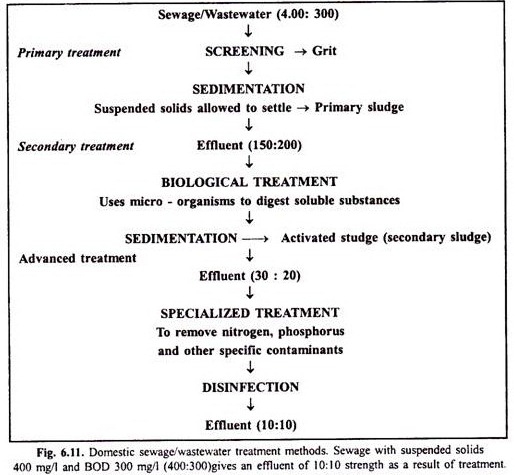ADVERTISEMENTS:
The greenhouse effect may be defined as warming of the earth’s climate owing to the increased concentrations of CO2 and some other gases in the atmosphere (Fig. 6.4).
The following greenhouse gases (GHG) are considered important:
(a) Carbon dioxide
(b) Nitrous oxide,
ADVERTISEMENTS:
(c) Methane,
(d) CFCs, and
(e) Ozone.
These gases act like the glass in a botanical greenhouse, trapping the reradiated heat near the earth’s surface and warning the planet. These gases along with water vapour and clouds absorb the infrared radiation, trapping heat near the earth’s surface. Carbon Dioxide (CO2):
Carbon Dioxide (CO2):
The CO2 is considered as the most dominant factor responsible for the Gh effect. The troposphere or lower atmosphere contains only 0.0325% CO2 (by volume) and its amount is controlled by a cycle, often called the carbon cycle.
ADVERTISEMENTS:
There are four major ‘pools’ or reservoirs of carbon:
Fossil fuels,
The atmosphere,
ADVERTISEMENTS:
The biosphere, and
The oceans.
Carbon dioxide concentration in the atmosphere has increased from 290 ppm (1860) to 350 ppm (today) and is expected to be 700 ppm in 2100. It was estimated in 1976 that the world consumption of about 5000 million tons of fossil fuels per year was contributing the equivalent of 2.3 ppm of CO2 to the atmosphere. The net annual increase of CO2 in the air is 0.77 ppm, which indicates that 1.6 ppm of fuel generated CO2 is being absorbed elsewhere perhaps into the oceans and the biosphere.
A continued increase in world fossil fuel combustion in the future can be expected to produce a further increase of CO2 in the troposphere (about 340 ppm in 1981), and this has been estimated at 20% by the year 2000. Thus it is widely accepted that during the last couple of decades the fossil fuels may have contributed more CO2 to the atmosphere than the terrestrial biosphere and that the oceans may not be able to absorb CO2 that is building up in the atmosphere. Clearance of forests is another factor for the increase of CO2.
ADVERTISEMENTS:
Nitrous oxide (N2O):
It is emitted to the atmosphere from biomass burning and artificial fertilizers, rising by 0.2% per year. Since it absorbs 259 times more heat than CO2, it contributes to global warming by increasing the greenhouse effect. It also destroys tropospheric ozone, which protects the earth from UV radiation.
Methane (CH4):
It is produced in a number of ways including the action of anaerobic bacteria on vegetation, decomposition of organic matter, incomplete combustion of vegetation, natural gas pipeline leaks and is rising by 2% per year. It absorbs 20-25 times more heat than CO2.
ADVERTISEMENTS:
CFCs:
There are large scale industrial uses of CFCs, which include aerosol propellants (CFC-11), refrigerants (CFC-12) and a wide range of solvents. The concentration of CFCs is rising nearly 5% per year. Like nitrous oxides, CFCs trap heat 20,000 times more efficiently than CO2 and also destroy ozone layer, thus posing a serious twofold environmental problem. The effect of CFCs is so powerful that by the year 2050 they alone could contribute more than CO2 to global warming (Dickson and Cicerone, 1986).
Ozone:
It comes mostly from hydrocarbons (HC) and nitrogen oxides (Nox). It causes irritation to eyes and respiratory organs. It also decreases the resistance power to infections and aggravates illness.
ADVERTISEMENTS:
Infra-red Absorption:
The CO2 is a greenhouse gas, that is, it remains transparent to the incoming shortwave solar radiation and absorbs the outgoing long wave radiation (infra-red or IR radiation). This absorptive property of CO2 prevents long wave IR, particularly the earth’s thermal radiation, being emitted to the outer atmospheric layers and lost into outer space (Fig. 6.4). The warming effect of this upon the atmospheric temperature has been linked to a “blanket” or ‘greenhouse effect’. The increasing concentration of CO2 in the atmosphere results in a ‘heat frap’ around the earth raising its temperature.
Thus, Gh effect is a phenomenon based on well established principles of infra-red (IR) absorption characteristics of gases. Besides CO2, a number of trace gases exhibit IR-absorption properties and contribute to the Gh effect. The dominant role of CO2 in producing the net Gh effect has been important due to its role in the evolution of the earth’s climate in the past billion years, and as a major pollutant released into the atmosphere as a result of man’s activities.
